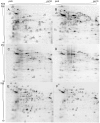An Insight into the proteome of Crithidia fasciculata choanomastigotes as a comparative approach to axenic growth, peanut lectin agglutination and differentiation of Leishmania spp. promastigotes
- PMID: 25503511
- PMCID: PMC4263474
- DOI: 10.1371/journal.pone.0113837
An Insight into the proteome of Crithidia fasciculata choanomastigotes as a comparative approach to axenic growth, peanut lectin agglutination and differentiation of Leishmania spp. promastigotes
Abstract
The life cycle of the trypanosomatid Crithidia fasciculata is monogenetic, as the unique hosts of these parasites are different species of culicids. The comparison of these non-pathogenic microorganisms evolutionary close to other species of trypanosomatids that develop digenetic life cycles and cause chronic severe sickness to millions of people worldwide is of outstanding interest. A ground-breaking analysis of differential protein abundance in Crithidia fasciculata is reported herein. The comparison of the outcome with previous gene expression profiling studies developed in the related human pathogens of the genus Leishmania has revealed substantial differences between the motile stages of these closely related organisms in abundance of proteins involved in catabolism, redox homeostasis, intracellular signalling, and gene expression regulation. As L. major and L. infantum agglutinate with peanut lectin and non-agglutinating parasites are more infective, the agglutination properties were evaluated in C. fasciculata. The result is that choanomastigotes are able to agglutinate with peanut lectin and a non-agglutinating subpopulation can be also isolated. As a difference with L. infantum, the non-agglutinating subpopulation over-expresses the whole machinery for maintenance of redox homeostasis and the translation factors eIF5a, EF1α and EF2, what suggests a relationship between the lack of agglutination and a differentiation process.
Conflict of interest statement
Figures





Similar articles
-
Adhesion of Crithidia fasciculata promotes a rapid change in developmental fate driven by cAMP signaling.mSphere. 2024 Oct 29;9(10):e0061724. doi: 10.1128/msphere.00617-24. Epub 2024 Sep 24. mSphere. 2024. PMID: 39315810 Free PMC article.
-
In vitro infectivity and differential gene expression of Leishmania infantum metacyclic promastigotes: negative selection with peanut agglutinin in culture versus isolation from the stomodeal valve of Phlebotomus perniciosus.BMC Genomics. 2016 May 20;17:375. doi: 10.1186/s12864-016-2672-8. BMC Genomics. 2016. PMID: 27206922 Free PMC article.
-
Genome-wide analysis reveals increased levels of transcripts related with infectivity in peanut lectin non-agglutinated promastigotes of Leishmania infantum.Genomics. 2009 Jun;93(6):551-64. doi: 10.1016/j.ygeno.2009.01.007. Epub 2009 Feb 10. Genomics. 2009. PMID: 19442635
-
What has proteomics taught us about Leishmania development?Parasitology. 2012 Aug;139(9):1146-57. doi: 10.1017/S0031182012000157. Epub 2012 Feb 28. Parasitology. 2012. PMID: 22369930 Review.
-
Evolution and expression of the Leishmania surface proteinase (gp63) gene locus.Infect Agents Dis. 1993 Feb;2(1):25-34. Infect Agents Dis. 1993. PMID: 8162351 Review.
Cited by
-
Dramatic changes in gene expression in different forms of Crithidia fasciculata reveal potential mechanisms for insect-specific adhesion in kinetoplastid parasites.PLoS Negl Trop Dis. 2019 Jul 29;13(7):e0007570. doi: 10.1371/journal.pntd.0007570. eCollection 2019 Jul. PLoS Negl Trop Dis. 2019. PMID: 31356610 Free PMC article.
-
Phosphoglycerate kinase: structural aspects and functions, with special emphasis on the enzyme from Kinetoplastea.Open Biol. 2020 Nov;10(11):200302. doi: 10.1098/rsob.200302. Epub 2020 Nov 25. Open Biol. 2020. PMID: 33234025 Free PMC article. Review.
-
Klf5 down-regulation induces vascular senescence through eIF5a depletion and mitochondrial fission.PLoS Biol. 2020 Aug 20;18(8):e3000808. doi: 10.1371/journal.pbio.3000808. eCollection 2020 Aug. PLoS Biol. 2020. PMID: 32817651 Free PMC article.
-
Adhesion of Crithidia fasciculata promotes a rapid change in developmental fate driven by cAMP signaling.mSphere. 2024 Oct 29;9(10):e0061724. doi: 10.1128/msphere.00617-24. Epub 2024 Sep 24. mSphere. 2024. PMID: 39315810 Free PMC article.
-
Leptomonas pyrrhocoris: Genomic insight into Parasite's Physiology.Curr Genomics. 2018 Feb;19(2):150-156. doi: 10.2174/1389202918666170815143331. Curr Genomics. 2018. PMID: 29491743 Free PMC article. Review.
References
-
- Wallace FG (1966) The trypanosomatid parasites of insects and arachnids. Exp Parasitol 18:124–193. - PubMed
-
- Olsen OW (1974) Animal Parasites. The Life Cycles and Ecology. London: University Park Press.
-
- Ibrahim EA, Molyneux DH (1987) Pathogenicity of Crithidia fasciculata in the haemocoele of Glossina. Acta Trop 44:13–22. - PubMed
-
- Schaub GA (1994) Pathogenicity of trypanosomatids on insects. Parasitol Today 10:463–468. - PubMed
-
- WHO (2010) Report of a Meeting of the WHO Expert Committee on the Control of Leishmaniases. Geneva.
Publication types
MeSH terms
Substances
LinkOut - more resources
Full Text Sources
Other Literature Sources
Molecular Biology Databases
Research Materials
Miscellaneous

